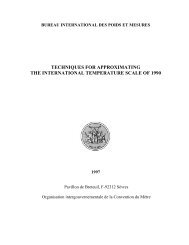On the measurement quality of UTC time transfer - BIPM
On the measurement quality of UTC time transfer - BIPM
On the measurement quality of UTC time transfer - BIPM
You also want an ePaper? Increase the reach of your titles
YUMPU automatically turns print PDFs into web optimized ePapers that Google loves.
Table 1 Examples <strong>of</strong> <strong>the</strong> Type A uncertainties (uA) in [<strong>UTC</strong>-<strong>UTC</strong>(k)] and in <strong>the</strong> link [<strong>UTC</strong>(k)–<strong>UTC</strong>(PTB)]<br />
k Link type uA in [<strong>UTC</strong>-<strong>UTC</strong>(k)] /ns uA in link [<strong>UTC</strong>(k)–<strong>UTC</strong>(PTB)]. / ns<br />
USNO PPP 0.3 0.3<br />
NICT TWPPP 0.3 0.3<br />
NIS P3 0.8 0.8<br />
SU GPSGLN 1.0 1.0<br />
NPLI MC 2.0 2.0<br />
ORB PPP 0.4 0.3<br />
NTSC MC 1.5 1.4<br />
Our study <strong>the</strong>refore focuses on <strong>the</strong> determination <strong>of</strong> <strong>the</strong> Type A uncertainty for different types <strong>of</strong> <strong>time</strong> link. It is<br />
based on a previous global study <strong>of</strong> <strong>the</strong> uncertainties [11], undertaken in conformity with GUM [3].<br />
1.1 Background<br />
The <strong>BIPM</strong> has <strong>the</strong> mandate to compute <strong>the</strong> international <strong>time</strong> scale Coordinated Universal Time (<strong>UTC</strong>) in <strong>the</strong><br />
form <strong>of</strong> [<strong>UTC</strong>-<strong>UTC</strong>(k)] and its uncertainty [1,20].<br />
The first global estimation <strong>of</strong> <strong>the</strong> uncertainty <strong>of</strong> <strong>the</strong> <strong>time</strong> links was published in December 2002 [11] based on a<br />
GUM-type analysis [2]). This 2002 evaluation was <strong>of</strong>ficially adopted in Circular T 194 <strong>of</strong> February 2004 [1]. At<br />
that <strong>time</strong> <strong>the</strong>re were 53 <strong>time</strong> links in total: 44 GPS CV links and 9 TW links. The <strong>UTC</strong> <strong>time</strong>-<strong>transfer</strong> network<br />
was structured around four pivotal laboratories: USNO (United States Naval Observatory ), NIST (National<br />
Institute <strong>of</strong> Standards and Technology), CRL (now NICT, National Institute <strong>of</strong> Information and Communications<br />
Technology) and PTB, cf. <strong>the</strong> Annex. The links were classified into four categories according to <strong>the</strong> type <strong>of</strong> link:<br />
(1) TW, (2) GPS CV MC operated under normal conditions, (3) GPS CV SC operated under normal conditions<br />
and (4) GPS links in poor conditions [11]. The number <strong>of</strong> TW <strong>measurement</strong> points was low, with only 2 or 3<br />
points per week, making it difficult to estimate <strong>the</strong> short-term uncertainty <strong>of</strong> TW links. Fur<strong>the</strong>rmore, <strong>the</strong> TW link<br />
<strong>measurement</strong> noise was masked by <strong>the</strong> clock noise so that <strong>the</strong> only indicator, TDev, could be interpreted as <strong>the</strong><br />
maximum uA <strong>of</strong> <strong>the</strong> TW links. Hence, <strong>the</strong> 2002 evaluation was based on <strong>the</strong> TDev over <strong>the</strong> least noisy hydrogen<br />
maser–hydrogen maser baseline available in each category.<br />
Since <strong>the</strong> 2002 evaluation, <strong>time</strong>-<strong>transfer</strong> techniques in <strong>the</strong> generation <strong>of</strong> <strong>UTC</strong> have evolved significantly with <strong>the</strong><br />
introduction <strong>of</strong> P3 CV (2004) [7], GPS All in View (2006) [13,14], PPP (2008) [8,16], TWPPP (2010) [5] as<br />
well as GLN (2009) and GPSGLN (2011) [6,15]. The conventional Type A uncertainties <strong>of</strong> <strong>the</strong>se new<br />
techniques are listed in Table 2. Considering this significant improvement in <strong>time</strong>-<strong>transfer</strong> techniques and <strong>the</strong><br />
possibility <strong>of</strong> directly comparing independent techniques, a new global re-evaluation <strong>of</strong> uA is <strong>time</strong>ly.<br />
Table 2 The Type A standard uncertainties <strong>of</strong> <strong>the</strong> <strong>time</strong>-<strong>transfer</strong> techniques introduced since 2005 in <strong>UTC</strong> <strong>time</strong> links<br />
Type <strong>of</strong> link uA / ns Introduced in<br />
P3 CV/AV 0.7 2004/2006<br />
GPSPPP 0.3 2008<br />
TWPPP 0.3 2011<br />
GLN 1.5 2009<br />
GPSGLN 1.2 2011<br />
1.2 Component <strong>of</strong> uA<br />
At present, <strong>the</strong>re are a total <strong>of</strong> 68 laboratories contributing to <strong>UTC</strong> (67 operational links).<br />
Until <strong>BIPM</strong> Circular T 286 (October 2011), uA was defined in Section 6 [1] as uA is <strong>the</strong> statistical uncertainty<br />
evaluated by taking into account: (1) <strong>the</strong> level <strong>of</strong> phase noise in <strong>the</strong> raw data, (2) <strong>the</strong> interpolation interval<br />
between data points, and (3) effects with typical duration between 5 and 30 days.<br />
In view <strong>of</strong> <strong>the</strong> currently available short <strong>measurement</strong> intervals, item (2) is insignificant: <strong>the</strong> TW <strong>measurement</strong><br />
interval has been reduced from typically 2 to 4 days (in 2002) to 1 to 2 hours [19]; <strong>the</strong> interval for GPS and GLN<br />
codes in CGGTTS format is 16 minutes, and for GPSPPP it is 5 minutes. The interpolation uncertainties are<br />
hence negligible. The third item has generally been determined first through a qualitative analysis <strong>of</strong> <strong>the</strong> main<br />
effects for each technique, and secondly through <strong>the</strong> comparisons <strong>of</strong> <strong>the</strong> independent link technique as well as<br />
<strong>the</strong> <strong>time</strong> series statistics and analysis. As an example, to estimate uA for GPS single frequency code<br />
<strong>measurement</strong>s, we estimate first <strong>the</strong> possible magnitude <strong>of</strong> ionospheric and tropospheric mismodelling and <strong>of</strong><br />
4
















